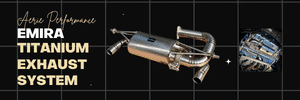NorCalEmira
Emira Fan
Look no farther than formula 1 for the apex of engineering. Mid engined (ahead of the rear axle)with a significant rearward weight bias is what you'll find.
Follow along with the video below to see how to install our site as a web app on your home screen.
Note: This feature may not be available in some browsers.
I assume this is an impactful mod. I’m surprised this is so little camber flexibility out of the box.Greg emailed me today that hopefully adjustable upper control arms may be ready by the end of the month.
I also noticed a discrepancy between the screen + what my solo was displaying (one of my Solo screens is setup to monitor vitals). I have the i4 Emira. Separately, on the road I have a bluetooth OBD reader which connects to my phone and there's a CarPlay app...it also shows different values from OBD vs dash.So, on a different topic, I logged my coolant temperature (OBD-II ECT channel in AIM). We had 102F outdoor temperature, and I was pushing hard. The coolant temperature started out around 195F at the beginning of a session, over a couple laps rose to 211F and then stayed between 211F and 219F for the remainder of the session.
The entire time, the instrument cluster display showed a flat 200F.
So, now, I have definitive proof that this car has "idiot gauges" which don't show real temperature, but rather a faked one to make you feel secure or something.
Are you sure it wasn’t just hot tire pickup from the marbles on the track. Would be hard-pressed to think actual asphalt deposited onto the tires. Hot tire pickup can result in tire vibrations from inconsistent contact patch as well as throw off the balance of the wheel tire and can impose a significant vibration with highway driving. Been tracking cars for years and even the guys running full racing slicks haven’t come off track with asphalt melted to the tire. Did it look like F1 tires do after the race?A question for you "track-rats": my last time in the Emira (3rd day; spread out over 2.5 months) on the track this past w/e, I came away with tires that picked up what appears to be "track asphalt" that seemed to be melted in uneven patches/lengths, onto the tires. This didn't happen the first 2 times, even though my first track day was very dry with a hotter track (it was warmer out and more people on the track) and tires that got hotter than this past time.
The track started out a bit wet due to rain the night before...followed by a bit of drizzle in the early morning, but the rest of the day the track was completely dry and it was ++ cloudy and the sun escaped the clouds for about 1.5 hours in the afternoon resulting in hotter temperatures (reaching about 25 degrees Celsius, or 77 degrees Fahrenheit, for ambient air). The humidity remained high the entire day; likely higher than the prior 2 track days. I didn't notice anything weird until driving home from the track after my last run in the late afternoon: I heard an odd noise which I first thought was brakes or something warped due to heat, but then learned it was tire noise due to the extra "coating" on parts of each tire, moreso the fronts. The fronts looked to be at least a third covered.
It took me 15 minutes to drive home, with half that distance at or near highway speeds. The next morning, I drove to work and listened to this same noise, in the 25 minute drive to my local tire shop including about 20 minutes of highway speed freeway driving. So none of that dislodged my unwelcome "tire passengers".
Is it due to increased wear on my (stock OEM summer Good Years) so less tread? That seems unlikely. I'll probably need to replace them, with 2 more track days. Or improper air in my tires? (unlikely; I did check when checking the lug nut torque). Or something due to track conditions? Or higher humidity? Or a combo? Has anyone experienced that? Other than paying over $300 to remove this, are there any other easier solutions?
Unfortunately, I didn't take any pictures before having my tire shop remove each tire to clean off its surface; a fun job since the asphalt was really stuck onto the surface. They peeled it by hand initially then purchased a solvent, to better pry it off and dig it out of the treads.

